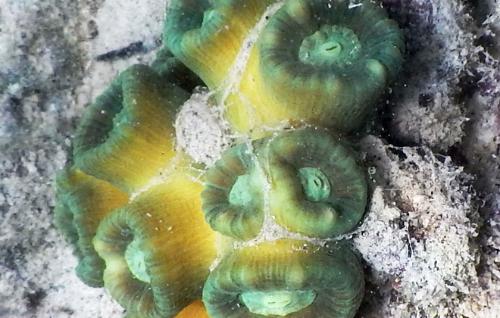Published in the Ocean Watch column, Honolulu Star-Advertiser © Susan Scott
December 8, 2014
I don’t write the headlines to my columns, but when I email one to the newspaper, I title it with a common name so the editors know what the piece is about. This week my subject gave me pause because it’s known only by its scientific order, Zoanthid, a name that doesn’t exactly roll off the tongue. When I looked up the word’s meaning, though, it painted a picture as pretty as the creatures themselves. “Zoanthid” is Greek for “flower animal.”A Palau zoanthid with tentacles tightly closed.
I don’t write the headlines to my columns, but when I email one to the newspaper, I title it with a common name so the editors know what the piece is about. This week my subject gave me pause because it’s known only by its scientific order, Zoanthid, a name that doesn’t exactly roll off the tongue. When I looked up the word’s meaning, though, it painted a picture as pretty as the creatures themselves. “Zoanthid” is Greek for “flower animal.”
 A Palau zoanthid with tentacles tightly closed.
A Palau zoanthid with tentacles tightly closed.
©2014 Susan Scott
An individual zoanthid body is leathery and round, about a half-inch across. Encircling the body are two rows of tiny waving tentacles that sting animals unfortunate enough to drift close. The tentacles drop their paralyzed catch into the creature’s mouth at the center.
Zoanthids don’t live alone like their solitary cousins the anemones. Like reef corals, zoanthids create colonies, expanding their communities by budding off each other. (Brand-new colonies start when mature bodies release eggs and sperm into the water.)
Some zoanthid bodies lie flat, like buttons, and others sit atop stumps or stems, like flowers. In most species the walls of the round bodies contain grains of sand that probably give some heft to the animals’ build.
A mat of rubbery tissue connects zoanthids’ bodies, making large colonies look like floral-patterned carpets draped over rocks. Channels inside the mats connect the individuals’ digestive systems, allowing zoanthids to share food.
Like their coral and anemone relatives, zoanthids host algae in their tissues that add veggies to the diet.
The color combinations and designs of zoanthids and their algae rival the world’s most famous summer gardens, making these creatures jewels of both reefs and aquariums. You can see some of these eye-popping animal flower beds at bit.ly/1ywm0EB.
Hawaii might — or might not — host eight species of zoanthids. Their appearances are so varied that Great Barrier Reef studies showed several so-called species are genetically identical. Conversely, several distinct species look remarkably alike, even when dissected.
We know for sure, however, that one rare kind of Hawaii zoanthid, called “limu-make-o-Hana” (“deadly seaweed of Hana”), can kill you. Its stingers aren’t potent enough to hurt humans, but the body contains a potent toxin.
Ancient Hawaiian warriors rubbed mucus from this Maui zoanthid on their spear tips, causing wounds to be fatal.
The poison might also save lives. Researchers have discovered that the palytoxin produced by algae or bacteria in the zoanthid has anti-cancer properties.
The sight of zoanthids blossoming on the reef or in an aquarium is memorable even if their name is not. But then, it’s hard to improve on “flower animal.”